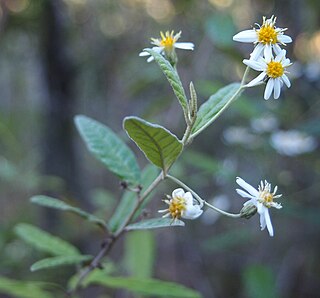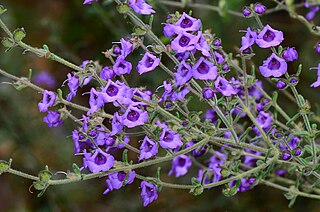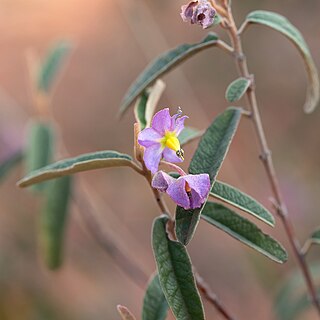
Boronia muelleri, commonly known as the forest boronia or pink boronia, is a flowering plant that occurs in forest, woodland and heath in Victoria and New South Wales in Australia. It is an erect, woody shrub or small tree with pinnate leaves and up to fifteen pink to white four-petalled flowers arranged in leaf axils in spring and summer.

Olearia stuartii is a species of flowering plant in the family Asteraceae and is endemic arid parts of inland Australia. It is compact, spreading shrub or undershrub with lance-shaped leaves and blue to mauve and yellow, daisy-like inflorescences.

Pultenaea muelleri, commonly known as Mueller's bush-pea, is a species of flowering plant in the family Fabaceae and is endemic to Victoria, Australia. It is a dense shrub with hairy stems, elliptic to narrow egg-shaped leaves with the narrower end towards the base, and yellow and red flowers arranged singly or in pairs on the ends of short side shoots.

Lasiopetalum floribundum, commonly known as free flowering lasiopetalum, is a species of flowering plant in the family Malvaceae and is endemic to the south-west of Western Australia. It is an erect or spreading shrub with hairy young stems, egg-shaped leaves and pale pink, mauve or white flowers.

Olearia canescens is a species of flowering plant in the family Asteraceae and is endemic to eastern Australia. It is a shrub with scattered elliptic or egg-shaped leaves, and white and yellow, daisy-like inflorescences.

Prostanthera hirtula, commonly known as hairy mintbush, is a species of flowering plant in the family Lamiaceae and is endemic to the south-eastern continental Australia. It is a strongly aromatic, densely hairy, spreading shrub with narrow egg-shaped leaves and dark mauve flowers, and that grows in exposed, rocky sites.

Persoonia brevifolia is a plant in the family Proteaceae and is endemic to a restricted area near the border between south-eastern New South Wales and Victoria. It is an erect shrub with elliptic to egg-shaped leaves and cylindrical yellow flowers arranged singly in leaf axils.

Seringia integrifolia, commonly known as common firebush, is a species of flowering plant in the family Malvaceae and endemic to the south-west of Western Australia. It is a small, much-branched shrub, its young growth densely covered with woolly, white or rust-coloured hairs. The leaves are oblong, 8.5–17 mm (0.33–0.67 in) long, more or less glabrous on the upper surface and densely covered with woolly white hairs on the lower surface. The flowers are arranged in small, loose groups with thin, egg-shaped bracts that fall off as the flowers open. The sepal lobes are broad, pointed, mostly 6.5–8.5 mm (0.26–0.33 in) long and the ovary has 5 carpels with about 4 ovules in each. The fruit is a spherical, softly hairy capsule.

Seringia hermanniifolia, commonly known as crinkle-leaved firebush, is a species of flowering plant in the mallow family and is endemic to the south-west of Western Australia. It is a low-growing or prostrate, suckering shrub with hairy new growth, hairy, wavy, oblong to egg-shaped leaves and mauve to bluish flowers arranged in groups of 3 to 8.

Grevillea leiophylla, commonly known as wallum grevillea, or dwarf spider oak, is a species of flowering plant in the family Proteaceae and is endemic to Queensland. It is a weakly erect to low-lying shrub with narrowly oblong to egg-shaped or more or less linear leaves, and clusters of pale to deep pink flowers.

Olearia iodochroa, commonly known as the violet daisy bush, is a species of flowering plant in the family Asteraceae and is endemic to south-eastern continental Australia. It is a shrub with branchlets densely covered with whitish hairs, narrowly egg-shaped leaves with the narrower end towards the base, and white or mauve, and cream-coloured, yellow or blue, daisy-like inflorescences.

Olearia magniflora, commonly known as splendid daisy-bush, is a small shrub with clusters of deep mauve to purple flowers.

Asterolasia grandiflora is a species of weak, open shrub or sub-shrub that is endemic to the southwest of Western Australia. It has oblong, elliptical or egg-shaped leaves and pink to mauve flowers arranged in umbels of about three flowers with a thick covering of star-shaped hairs on the back of the petals.

Prostanthera chlorantha, commonly known as green mintbush, is a species of flowering plant in the family Lamiaceae and is endemic to the south-east of South Australia. It is a small shrub with small, broadly egg-shaped to round leaves and mauve, bluish green, or greenish red to greenish yellow flowers with a pink tinge.
Hibbertia banksii is a species of flowering plant in the family Dilleniaceae and is native to Queensland and New Guinea. It is a shrub with thick, leathery leaves and yellow flowers with about twenty to forty-eight stamens arranged on one side of the two carpels.

Thryptomene parviflora is a species of flowering plant in the family Myrtaceae and is endemic to Queensland. It is a slender, erect shrub with decussate, linear to egg-shaped leaves with the narrower end towards the base, and flowers with five petals and five stamens arranged singly in leaf axils.
Lasiopetalum laxiflorum is a species of flowering plant in the family Malvaceae and is endemic to the south-west of Western Australia. It is a sticky, straggling subshrub or shrub with many densely hairy stems, egg-shaped leaves, and bright pink and dark red flowers.

Olearia gravis is a species of flowering plant in the family Asteraceae and is endemic to south-eastern Australia. It is a shrub with elliptic or egg-shaped leaves and white and yellow, daisy-like inflorescences.
Olearia picridifolia, commonly known as rasp scrub-daisy, is a species of flowering plant in the family Asteraceae and is endemic to southern continental Australia. It is a low, spreading shrub with narrowly egg-shaped or narrowly elliptic leaves, and blue, mauve or white and yellow, daisy-like inflorescences.

Seringia collina is a species of flowering plant in the family Malvaceae and is endemic to Queensland. It is a low growing, small rounded shrub with hairy branches, oblong to egg-shaped leaves and usually purple flowers in groups of 3 to 6.

















